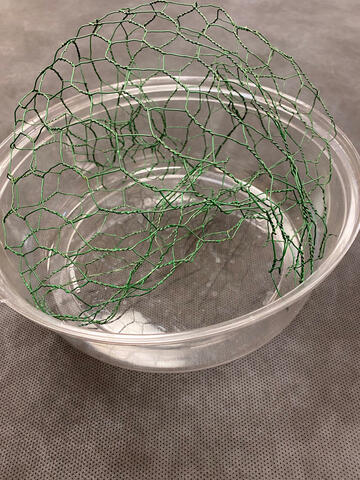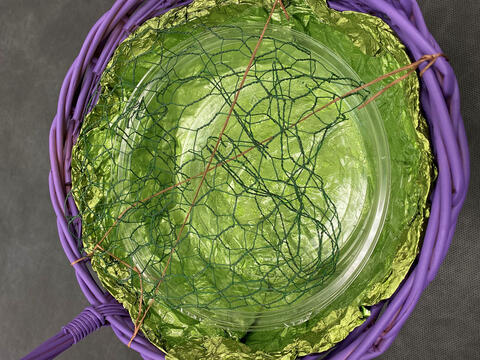P3733
Chicken Wire Mechanics for a Wicker Basket Arrangement for the Professional Florist
Professional floral designers have a wide assortment of floral design mechanics available to them through floral supply companies and florist wholesalers. Florists should embrace new and tried-and-true mechanics and make them part of their design repertoire. Practicing with a variety of mechanics will pay off in the event you can’t find your favorite items.
Mechanics
There is newfound interest in alternatives to fresh flower foams. Some designers are using chicken wire, also called poultry netting, as a substitute for floral foam. Before we address floral foam and chicken wire use, it is important to understand the definition of the term “mechanics.” The American Institute of Floral Designers (AIFD) defines mechanics as
a collective term for devices or techniques that help to secure materials and create stability in a floral composition. Mechanics are ordinarily concealed but may be deliberately exposed for artistic effect. Sound mechanics are the foundation for good design work.
Fresh Flower Foam
Phenolic floral foams are made from petroleum. They contain compounds that leach from the foam into the water-holding solution in which they are soaked. One of these compounds is a trace amount of formaldehyde.
Floral foams are safe to use, but some shops have soaking bins that are not regularly emptied and sanitized. If the soaking bin is not drained and cleaned after use, the compounds can concentrate in the water. Another problem with this practice is that microbes can grow in the soaking-bin water. Microbes lead to stem blockages that shorten vase life—the time flowers remain beautiful and usable.
The best practice for hydrating fresh flower foam is to soak only the amount needed for the day. At the end of the day, dispose of the water and sanitize the bin with a quaternary ammonium (quat) disinfectant. Such cleaning solutions are available from floral supply companies. If these are not available, household detergent is the next best thing.
Chicken Wire
This mechanic preceded floral foam in floral design history. It is added in layers or stuffed into a container. It is important to fold it so that stems penetrate at least two layers of the wire, with an approximate separation of 1 inch between levels. Multiple layers of the wire control stem placements.
Some florists use a layer of chicken wire on top of fresh flower foam, especially in large-scale arrangements. The added rigidity of the wire layer keeps large stems—such as flowering branches, gladiolus, and protea—in place.
Chicken wire used in floral design is typically 24-gauge wire painted dark green. This makes it easy to conceal and slows rusting.
There are advantages and disadvantages to using chicken wire mechanics.
Advantages
- Chicken wire is inexpensive, depending on the source and quantity purchased. If purchased in bulk, it costs only about 50 cents per foot. Some sources oriented toward the craft market may charge much more for smaller quantities.
- Chicken wire is reusable. While customers don’t typically return their containers and mechanics, florists regularly collect their containers (and associated mechanics) after weddings and events.
- It is malleable and can be formed into multiple shapes and sizes.
Disadvantages
- Poultry netting is made of metal wire, so it rusts and disintegrates.
- Rust can leave stains that are difficult to remove from glass, crystal, and porcelain.
- The wire is sharp and can cut, scrape, and puncture your skin.
- The chicken wire is in water, so spills are more common than when working with floral foam.
Wicker Basket Arrangement
We chose a wicker basket to make this floral design. Because this design is in a shallow container of water, it is not easy to transport, so consider making it in place rather than delivering it to the site.
Materials
- Chicken wire rectangle, about 6 by 12 inches
- Durable plastic liner
- Poly foil
- Paper-covered wire
- Wicker basket, about 14 inches diameter
- Floral paint
- Double-faced satin ribbon
- Multipurpose shears, florist knife
- Matthiola incana (stock), small, 4 bunches
- Ivy stems, about 6






For related information, see these MSU Extension publications at extension.msstate.edu:
Chicken wire mechanics for a large vase arrangement for the professional florist (P3732)
Snapdragon (Antirrhinum majus) for the farmer florist (P3301)
Stock (Matthiola incana) for the farmer florist (P3252)
References
Butler, S., DelPrince, J., Fowler, C., Gilliam, H., Johnson, J., McKinley, W., Money-Collins, H., Moss, L., Murray, P., Pamper, K., Scace, P., Shelton, F., Verheijen, A., & Whalen, K. (2005). The AIFD guide to floral design. Intelvid.
Dole, J., Stamps, R., Carlson, A., Ahmad, I., & Greer, L. (2017). Postharvest handling of cut flowers and greens (J. Laushman, Ed.). Association of Specialty Cut Flower Growers.
Hunter, N. (2013). The art of floral design (3rd ed.). Delmar.
Wood, M. (2007). The seasonal home. Winward.
Johnson, J., McKinley, W., & Benz, B. (2001). Flowers: Creative design. San Jacinto.
Scace, P. D., & DelPrince, J. (2020). Principles of floral design (2nd ed.). Goodheart-Willcox.
This publication is dedicated to the memory of Mr. Lew Kull, a retail florist in Canton, Ohio. Mr. Kull received professional floristry training through the GI Bill. He purchased a floral shop in 1951 and named it Lew Kull Florists. He recruited the author of this publication, Jim DelPrince, as a store manager and designer in 1983 and taught him the benefits and detriments of chicken wire floral design mechanics, in addition to thousands of other techniques.
The information given here is for educational purposes only. References to commercial products, trade names, or suppliers are made with the understanding that no endorsement is implied and that no discrimination against other products or suppliers is intended.
Publication 3733 (POD-04-25)
By James M. DelPrince, PhD, AIFD, PFCI, Associate Extension Professor, Coastal Research and Extension Center.
The Mississippi State University Extension Service is working to ensure all web content is accessible to all users. If you need assistance accessing any of our content, please email the webteam or call 662-325-2262.
